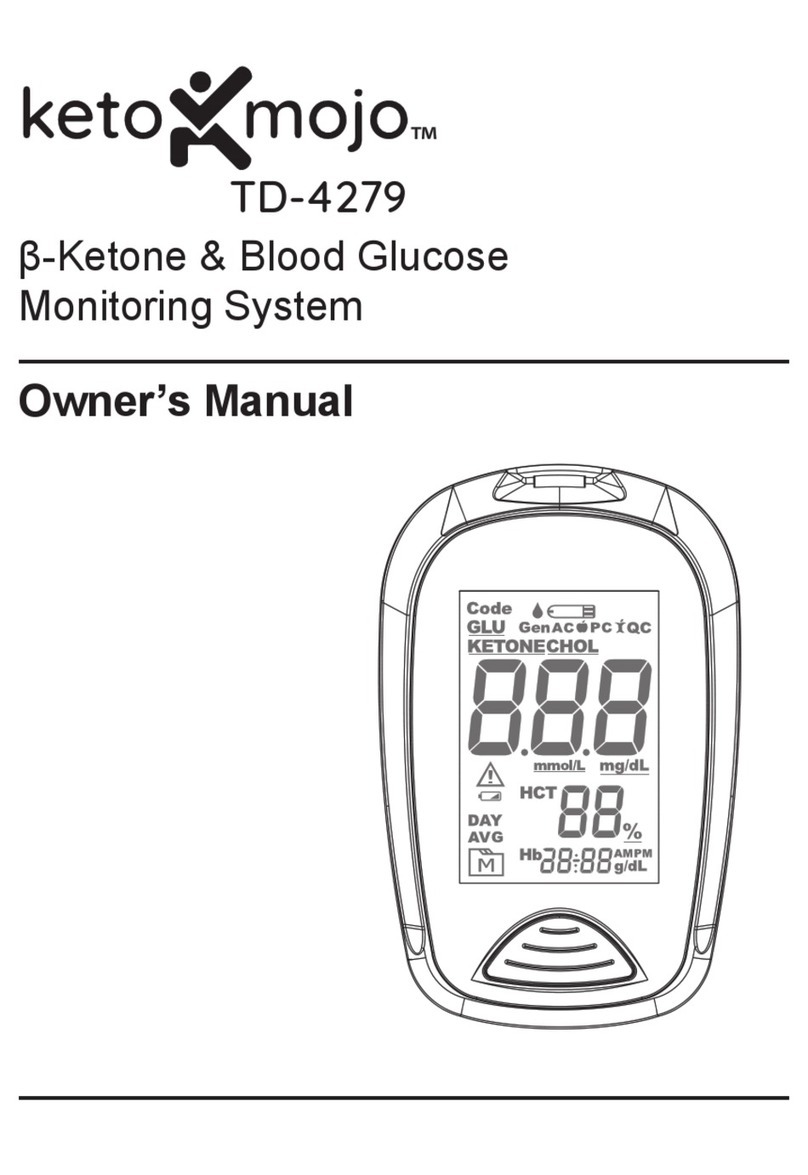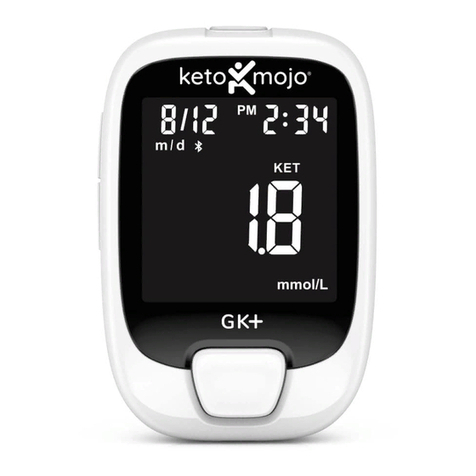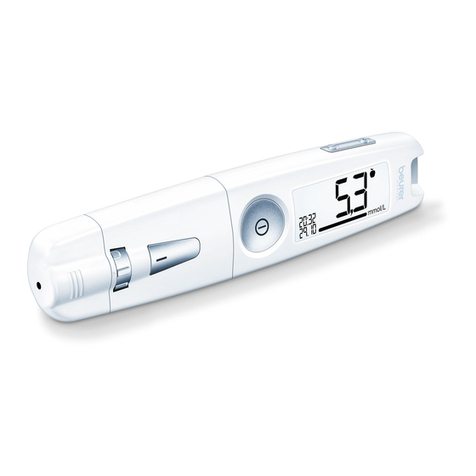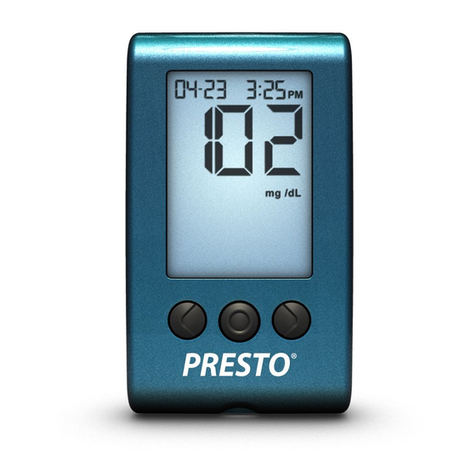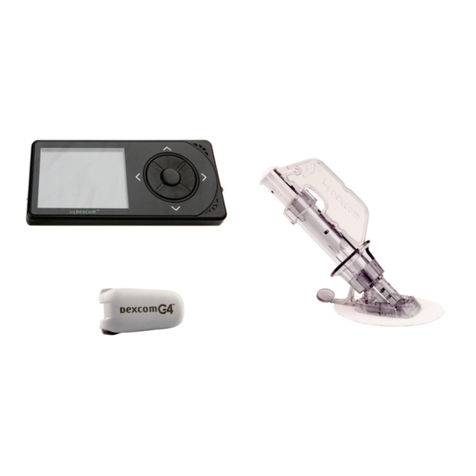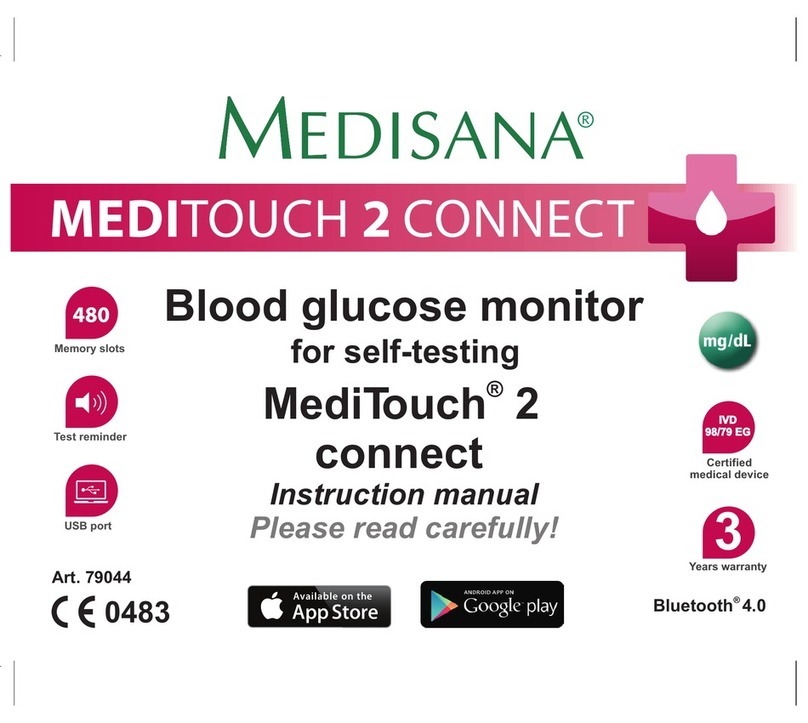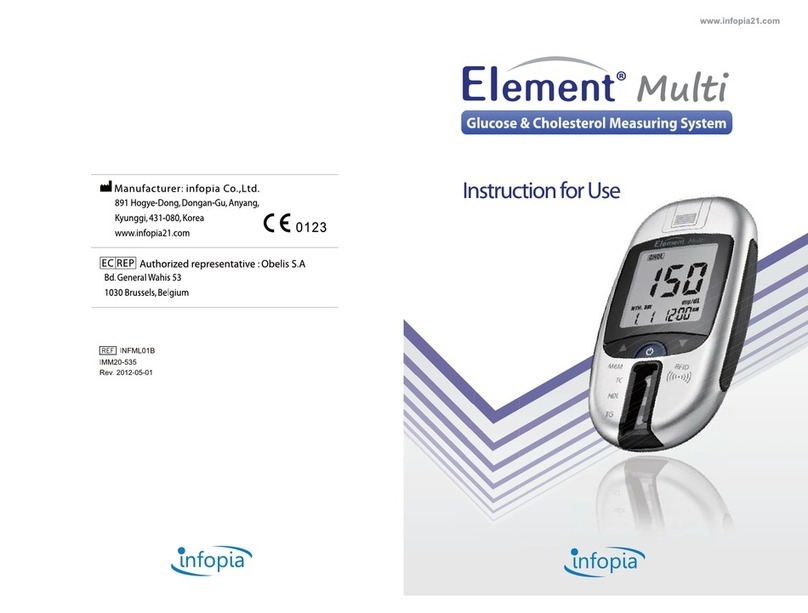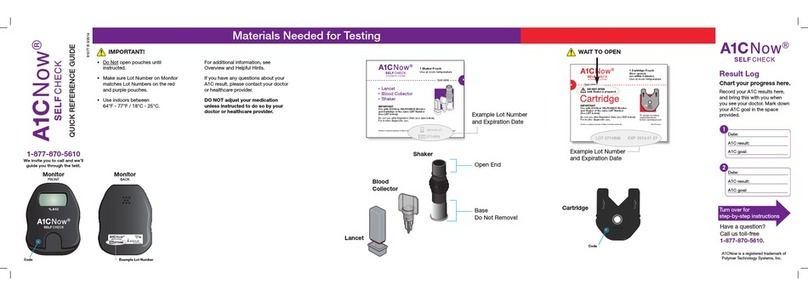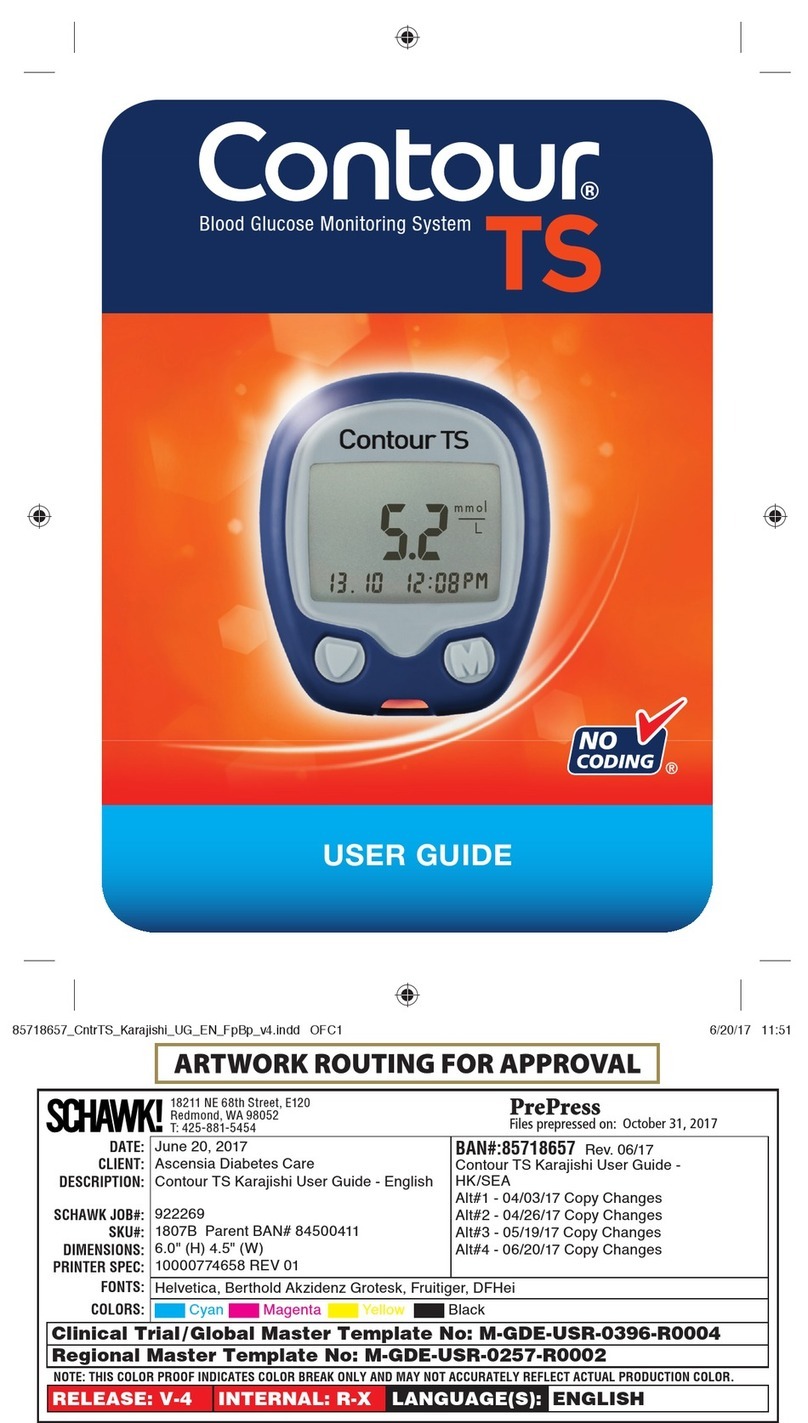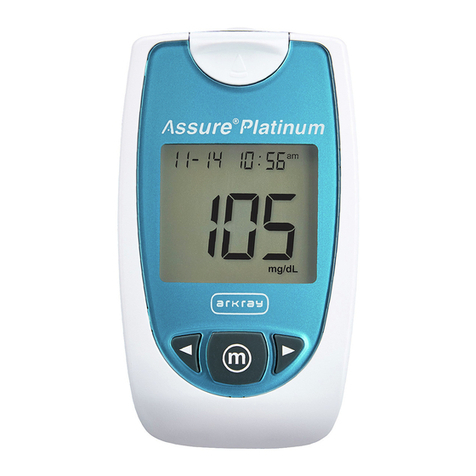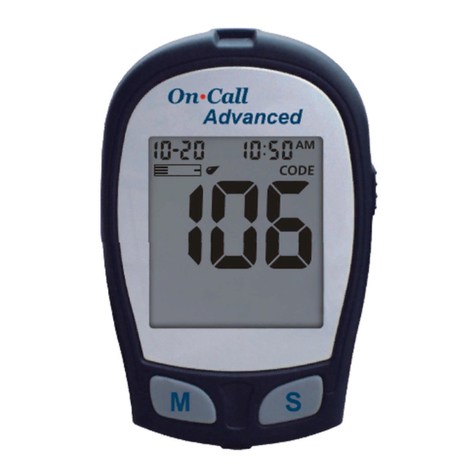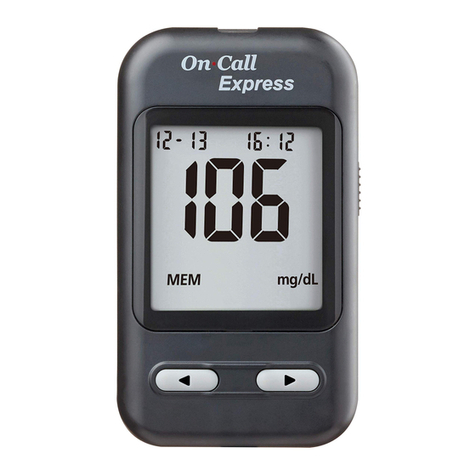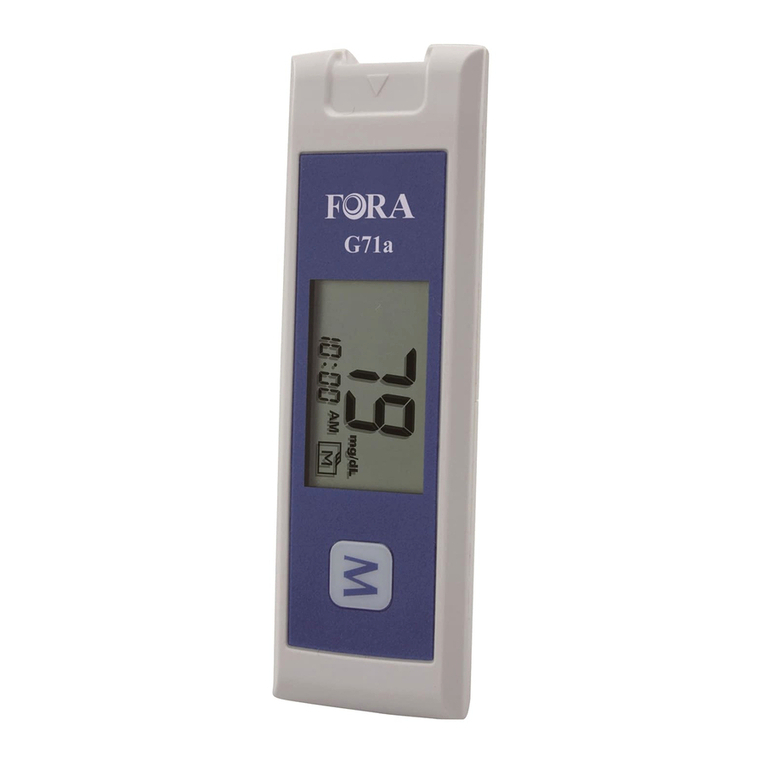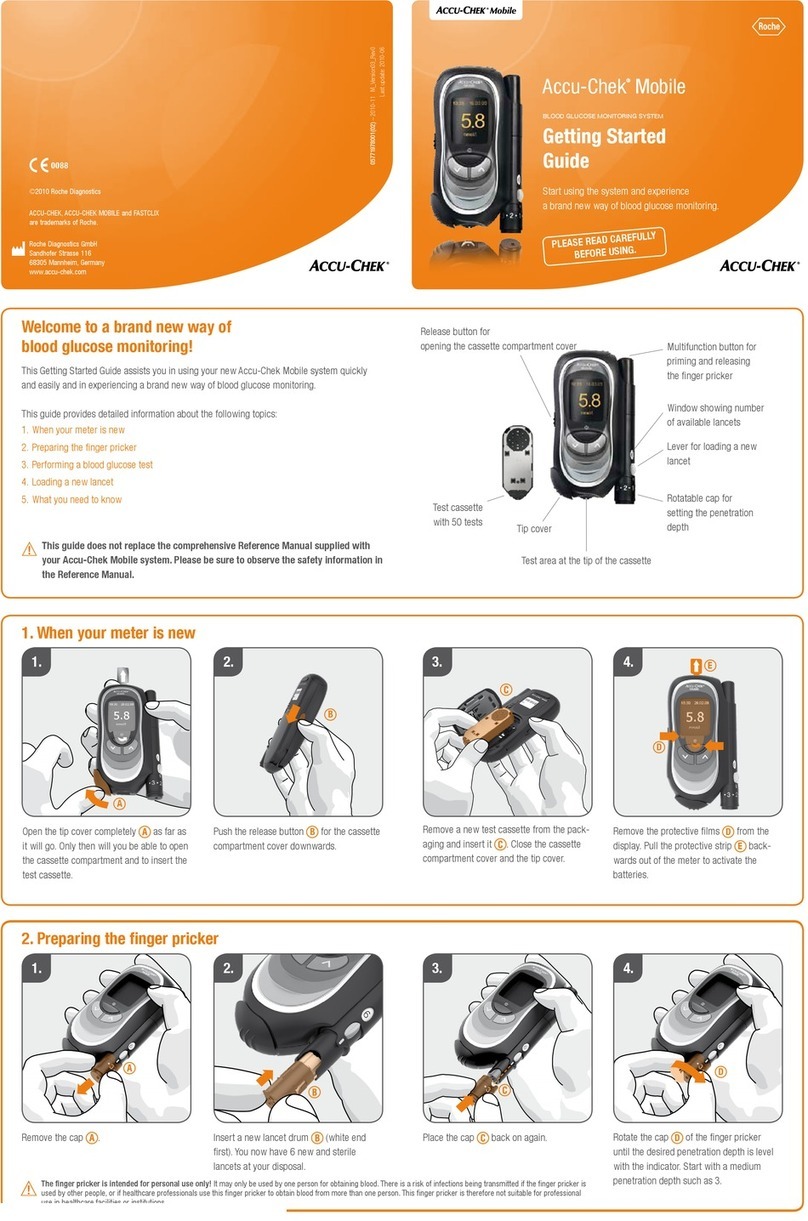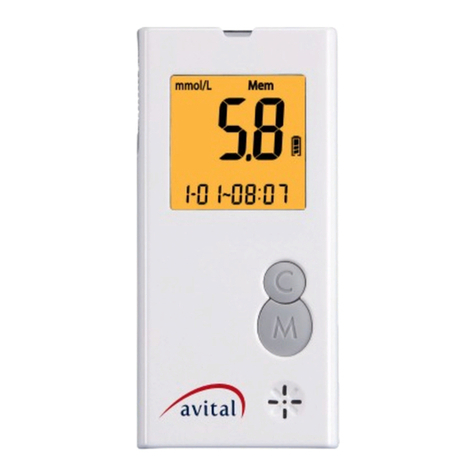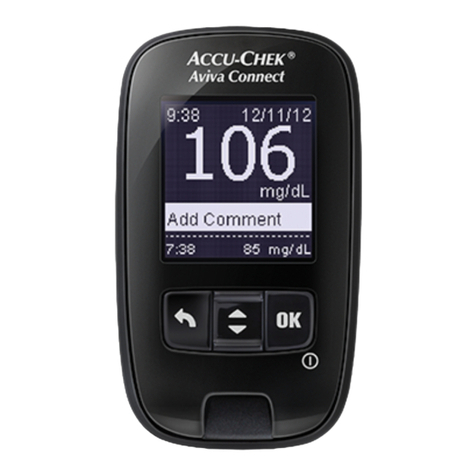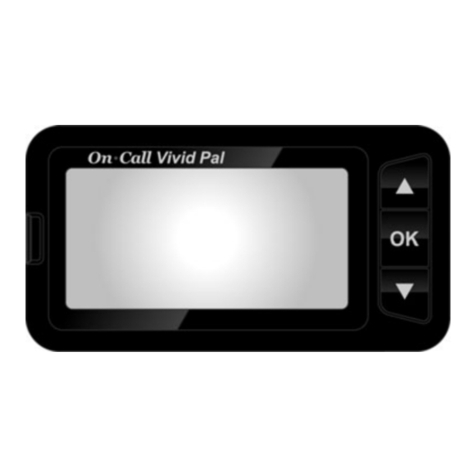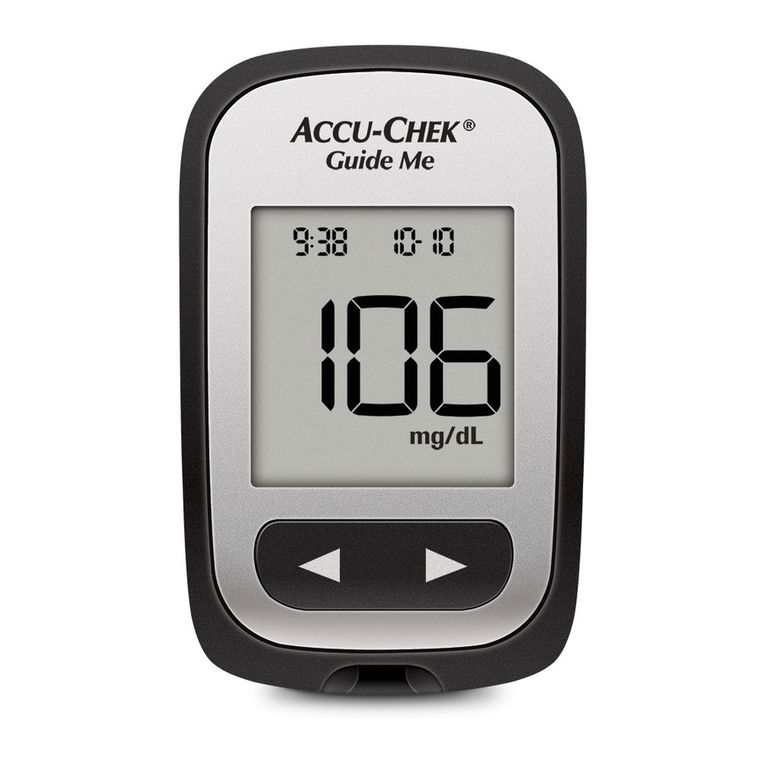Keto-Mojo TD-4279 User manual

β-Ketone & Blood Glucose Monitoring System
Owner’s Manual

Dear Keto-Mojo System Owner:
Thank you for purchasing the Keto-Mojo β-Ketone & Blood Glucose
Monitoring System. This manual provides important information to help
you to use the system properly. Before using this product, please read the
following contents thoroughly and carefully.
The system measures both blood glucose and β-ketone. Regular
monitoring of your blood glucose and β-ketone levels can help you and
your doctor gain better control of your diabetes. Due to its compact size
and easy operation, you can use the Keto-Mojo β-Ketone & Blood
Glucose Monitoring System to easily monitor your blood glucose and β-
ketone levels by yourself anywhere, any time.
If you have other questions regarding this product, please contact
KETO-CHECK Customer Support at 800.513.1965 (10 am - 4 pm PST).
Intended Use
This Keto-Mojo β-Ketone & Blood Glucose system is intended for the
quantitative measurement of glucose in fresh capillary whole blood from
the finger, and for the quantitative measurement of β-Ketone (beta-
hydroxybutyrate) in fresh capillary whole blood from the finger. The
system is intended for in vitro diagnostic use and for single-patient use as
an aid to monitoring the effectiveness of a diabetes control program. The
system should not be used for the diagnosis of, or screening for, diabetes,
nor for use on neonates.

Test Principle
Your system measures the amount of glucose/β-ketone in whole blood.
The glucose/β-ketone testing is based on the measurement of electrical
current generated by the reaction of glucose/β-ketone with the reagent of
the strip. The meter measures the current, calculates the glucose/β-
ketone level, and displays the result. The strength of the current produced
by the reaction depends on the amount of glucose/β-ketone in the blood
sample.
Version 1.0 2019/06
311-4279400-006

IMPORTANT SAFETY INSTRUCTIONS
READ BEFORE USE
The meter and lancing device are for single patient use. Do not
share them with anyone including other family members! Do not
use on multiple patients!
All parts of the kit are considered biohazardous and can potentially
transmit infectious diseases, even after you have performed
cleaning and disinfection.
For more information, please visit
1. “FDA Public Health Notification: Use of Fingerstick Devices on
More than One Person Poses Risk for Transmitting Bloodborne
Pathogens: Initial Communication” (2010)
http://wayback.archive-
it.org/7993/20170111013014/http://www.fda.gov/MedicalDevices/
Safety/AlertsandNotices/ucm224025.htm
2. “CDC Clinical Reminder: Use of Fingerstick Devices on More than
One Person Poses Risk for Transmitting Bloodborne Pathogens”
(2010)
http://www.cdc.gov/injectionsafety/Fingerstick-DevicesBGM.html
1. Use this device ONLY for the intended use described in this
manual.
2. Do NOT use accessories which are not specified by the
manufacturer.
3. Do NOT use the device if it is not working properly or if it is
damaged.

4. Do NOT under any circumstances use the device on the
neonates.
5. This device does NOT serve as a cure for any symptoms or
diseases. The data measured is for reference only.
6. Before using this device, read all instructions thoroughly and
practice the test. Carry out all the quality control checks as
directed.
7. Keep the device and testing equipment away from young
children. Small items such as the battery cover, batteries, test
strips, lancets and vial caps are choking hazards.
8. Do not use this instrument in close proximity to sources of strong
electromagnetic radiation, as this may interfere with the accurate
operation.
9. Proper maintenance and periodically control solution test are
essential to the longevity of your device. If you are concerned
about your accuracy of measurement, please contact your local
customer service or place of purchase for help.
10. Use only Keto-Mojo Glucose Test Strips with Keto-Mojo
β-Ketone & Blood Glucose Monitoring System to obtain accurate
results, and be covered by the manufacturer’s warranty.
KEEP THESE INSTRUCTIONS IN A SAFE PLACE

TABLE OF CONTENTS
BEFORE YOU BEGIN ............................................................................................1
Important Information.................................................................... 1
Limitation ...................................................................................... 1
Meter Overview............................................................................. 2
Display Screen.............................................................................. 3
Test Strip....................................................................................... 4
Contents of System ...................................................................... 5
SETTING THE METER...........................................................................................5
THE MEASURING MODES....................................................................................8
For Blood Glucose Testing............................................................ 8
For β-Ketone Testing .................................................................... 8
BEFORE TESTING ................................................................................................8
Calibration (for β-Ketone test) ...................................................... 8
How to Code Your Meter (for β-Ketone test)(b) ............................ 8
Checking the Code Number (c) .................................................... 9
Performing a Control Solution Test ............................................. 10
TESTING WITH BLOOD SAMPLE.......................................................................12
Preparing the Lancing Device for Blood Testing......................... 12
Preparing the Puncture Site ....................................................... 12
Performing a Blood Glucose or β-Ketone Test ........................... 13
METER MEMORY ................................................................................................16
Reviewing Test Results............................................................... 16
Reviewing Blood Glucose Day Average Results ........................ 16
BLUETOOTH PAIRING ........................................................................................17
Data Transmission via Bluetooth ................................................ 17
MAINTENANCE ...................................................................................................19
Battery ........................................................................................ 19
Caring for Your Meter.................................................................. 20
Disinfecting Procedures.............................................................. 21
Caring for Your Test Strips .......................................................... 23
Important Control Solution Information ....................................... 24
MEASUREMENT RESULTS READINGS .............................................................25
For Blood Glucose Test .............................................................. 25
For β-ketone Test........................................................................ 25
Detailed Information.................................................................... 26
Comparing Meter and Laboratory Results.................................. 27
Error Messages .......................................................................... 28
Troubleshooting .......................................................................... 29
SPECIFICATIONS ................................................................................................31



1
BEFORE YOU BEGIN
Important Information
If your blood glucose results or β-ketone are lower or higher than
usual, and you do not have any symptoms of illness, first repeat
the test. If you have symptoms or continue to get results which
are higher or lower than usual, follow the treatment advice of
your healthcare professional.
Use only fresh whole blood samples to test your blood glucose
or β-ketone. Using other substances will lead to inaccurate
results.
If you are experiencing symptoms that are inconsistent with your
blood glucose or β-ketone test results and you have followed all
the instructions given in this owner’s manual, contact your
healthcare professional.
The device should not be used on severely hypotensive
individuals or patients in shock. Readings which are lower than
actual values may occur for individuals experiencing a
hyperglycemic- hyperosmolar state, with or without ketosis.
Please consult the healthcare professional before use.
Limitation
The device should not be used on individuals in hyperglycemic-
hyperosmolar state, with or without ketosis; not for neonatal use;
not for use on critically ill patients.
For over-the-counter use.
The device is not intended for use in healthcare or assisted-use
settings such as hospitals, physician offices, or long-term care
facilities because it has been cleared by FDA for use in these
settings, including for routine assisted testing or as part of
glycemic control procedures. Use of this device on multiple
patients may lead to transmission of Human Immunodeficincey
Virus(HIV), Hepatitis C Virus (HCV), Hepatitis B Virus (HBV), or
other blood borne pathogens.

2
Meter Overview
①Test Strip Slot / Strip Port Communication
Insert test strip here to turn the meter on for testing.
Connect strip port cable for data transmission.
②Bluetooth Indicator Light
③Display Screen
④Main Button (M)
⑤Test Strip Ejector
Eject the used strip by pushing up this button.
⑥Bluetooth Switch
Activate the Bluetooth function.
⑦SET Button (S)
Enter and confirm the meter settings.
⑧Battery Compartment

3
Display Screen
①Glucose Symbol ⑫Measuring Mode
②Ketone Symbol AC – before meal
PC – after meal
Gen – any time of day
③Test Result ⑬Test Strip Symbol
④Error Message/
Ketone Waning
⑭Blood Drop Symbol
⑤Low Battery Symbol ⑮Code
⑥Day Average
⑦Memory Mode
⑧Date / Time
⑨Measurement Unit
⑩Alarm Reminde
r
⑪Auto QC Mode
/
QC Mode
QC- control solution
test

4
Test St r ip
Absorbent Hole
Confirmation Window
Test Strip Handle
Contact Bars
ATTENTION:
The front side of the test strip should face up and the
contact bar should be fully inserted into the test slot
in order to correctly turn on the meter and take
measurements.
NOTE
The Keto-Mojo monitor should only be used with Keto-Mojo
Glucose or β-Ketone Test Strips. Using other test strips with
this meter can produce inaccurate results.
Do not use any other test strips including any other Keto-Mojo
test strips or the result may be incorrect.
1
2
3
4

5
Contents of System
1. Keto-Mojo β-ketone & blood glucose monitoring system
2. Keto-Mojo β-ketone test strips
3. Keto-Mojo glucose test strips
4. Lancing device
5. Lancets
6. Protective wallet
7. Batteries
8. Manual/instructions
Test strips (e), control solution (f), lancing device (g) or sterile lancets
(h) are optional and may not be included in the kit (please check the
contents in your product box). They can be purchased separately.
Please make sure you have all items needed for a blood glucose or
ketone test beforehand.
SETTING THE METER
Before using your meter for the first time.
Entering the Setting Mode (a)
Start with the meter off (no test strip inserted). Press S.
1. Setting the date
The sequence of the date setting is: YEAR →MONTH →DAY.
With the YEAR / MONTH / DAY flashing in sequence, press Mto
select the correct number. Press S.

6
2. Setting the time format
Press M to select the desired time format ---12h or 24h. Press S.
3. Setting the time
With the HOUR / MINUTE flashing in sequence, press M until the
correct hour/minute appears. Press S.
4. Setting the unit of measurement
Press Mto switch between mg/dL and mmol/L. Press S.
5. Setting the buzzer
With the buzzer displays, press Mto switch between “On” and
“OFF”. Press S.
6. Deleting the memory
With “dEL” and a flashing “ ” on the display, press Mand select
“no” to keep the results in memory then press S to skip. To delete
all the results, press Mand select “yes” to delete all the memory
records.
7. Setting the reminder alarm
Your meter has four reminder alarms. The meter will display “OFF”
and “AL1”. If you don’t want to set an alarm, press Sto skip this
step; or press Mto select “On”, then press S.
With the hour/minute flashing in sequence, press Mto select the
correct hour/minute. Press Sand go to the next alarm setting.
NOTICE:
When the alarm beeps, press M to switch it off. Otherwise, it will
beep for 2 minutes then switch off.

7
8. Setting the auto send (For Keto-Mojo)
Press Mto select the auto-send (“AS”) “On” or “OFF”. Press S.
NOTICE:
When the alarm beeps, press M to switch it off. Otherwise, it will
beep for 2 minutes then switch off.
9. Setting the backlight
The default setting for meter backlight ("BL") is set to ON. Press
M to switch between “On” and “OFF”. Press S.
Congratulations! You have completed all settings!
NOTE:
These parameters can ONLY be changed in the setting mode.
If the meter is idle for 3 minutes during the setting mode, it will
switch off automatically.

8
THE MEASURING MODES
For Blood Glucose Testing
The meter provides you with three modes for measuring, General, AC,
and PC. You can switch between each mode by:
1. Start with the meter switched off. Insert a test strip to turn on the
meter. The screen will display a flashing “ ” and “Gen”.
2. Press Mto switch between Gen, AC and PC mode.
For β-Ketone Testing
The meter provides you with one mode for measuring, General. You
can start with the meter switched off. Insert a test strip to turn on the
meter. The screen will display a flashing “ ” and “Gen”.
BEFORE TESTING
Calibration (for β-Ketonetest)
You must calibrate the meter every time you begin to use a new vial
of β-Ketone test strips by setting the meter with the correct code. Test
results may be inaccurate if the code number displayed on the
monitor does not match the number printed on the strip vial.
How to Code Your Meter (for β-Ketone test)(b)
1. Insert the code strip when the monitor is off. Wait until the code
number appears on the display.
NOTICE:
Make sure the code number on display, code strip, and test strip vial are
the same. The code strip should be within the expiry date; otherwise, an
error message may appear.

9
2. Remove the code strip, the display will show “OK”. This tells you
that the meter has finished coding and is ready for β-ketone
testing.
CheckingtheCodeNumber(c)
You need to make sure that the code number displayed on the meter
matches the number on your test strip vial before you proceed. If it
matches, you can proceed with your test. If the codes do not match,
please stop testing and repeat the calibration procedure. If the
problem persists, contact Customer Service for help.
NOTICE:
The codes used in this manual are examples only; your meter may
display a different code.
WARNING:
It is important to make sure that the LCD displayed code is the
same as the code on your test strip vial before testing. Failure to
do so will get inaccurate results.
The code number for β-Ketone strip is three-digits; please ensure
you are using the correct strips for the test.
If the LCD displayed code is not the same as the code on your test
strip vial and the code number cannot be updated, please contact
Customer Service for assistance.

10
CONTROL SOLUTION TESTING
Our Control Solution contains a known amount of glucose/β-ketone
that reacts with test strips and is used to ensure your meter and test
strips are working together correctly.
Do a control solution test when:
You first receive the meter
At least once a week to routinely check the meter and test strips
You begin using a new vial of test strips
You suspect the meter or test strips are not working properly
Your blood glucose or ketone test results are not consistent with
how you feel, or if you think the results are not accurate
Practicing the testing process, or
You have dropped or think you may have damaged the meter
Performing a Control Solution Test
To perform a control solution test, you will need: (d), (e) and (f).
1. Insert the test strip to turn on the meter
Wait for the meter to display “ ” and “ ”.
2. Apply control solution (i)
Shake the control solution vial thoroughly before use. Squeeze
out the first drop and wipe it off, then squeeze out another drop
and place it on the tip of the vial cap. Hold the meter to move the
absorbent hole of the test strip to touch the drop. Once the
confirmation window fills completely, the meter will begin counting
down.

11
NOTE:
To avoid contaminating the control solution, do not directly
apply control solution onto a strip.
For blood glucose or β-ketone test, your device will tag this
measurement as QC test automatically.
3. Read and compare the result
After counting down to 0, the control solution test result will appear
on the display. Compare this result with the range printed on the
test strip vial and it should fall within this range. If not, please read
the instructions again and repeat the control solution test.
With “QC” displayed, the meter will store your test result in
memory under “QC”.
Out-of-range results
If you continue to have test results fall outside the range printed on
the test strip vial, the meter and strips may not be working properly.
Do NOT test your blood and call customer service for help.
NOTE:
The control solution range printed on the test strip vial is for control
solution use only. It is not a recommended range for your blood test
level.
See the MAINTENANCE section for important information about your
control solutions.

12
TESTING WITH BLOOD SAMPLE
WARNING:
To reduce the chance of infection:
Never share a lancet or the lancing device.
Always use a new, sterile lancet. Lancets are for single use only.
Avoid getting hand lotion, oils, dirt, or debris in or on the lancets and
the lancing device.
Wash and dry your hands thoroughly after handling the meter, lancing
device and test strips to prevent infection. For more information,
please refer to the “Cleaning and Disinfection” section.
If another person is assisting with the measurement and he or she is
responsible for operating the meter, that person should clean and
disinfect the meter and lancing device prior to the measurement.
Sharing the lancing device and lancets may increase the risk of
contracting infectious diseases. Lancing device must not be used
for more than one person.
Preparing the Lancing Device for Blood Testing
Please follow the instructions in the lancing device insert for collecting
a blood sample.
Preparing the Puncture Site
Stimulating blood perfusion by rubbing the puncture site before blood
extraction has a significant influence on the accuracy of the glucose
or β-ketone value obtained. Blood from a site that has not been
rubbed exhibits a measurably different glucose or β-ketone
concentration than blood from the finger. If the puncture site was
rubbed prior to blood extraction, the difference is significantly reduced.
Other manuals for TD-4279
1
Table of contents
Other Keto-Mojo Blood Glucose Meter manuals
